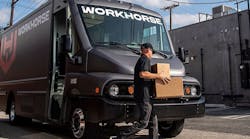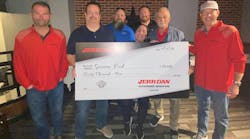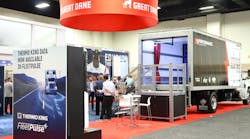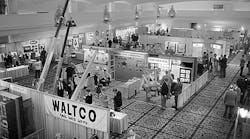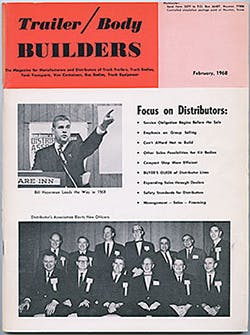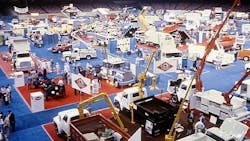A GROUP of truck equipment distributors wasn’t real happy about this time 50 years ago. The reason: They felt that their industry trade association was charging them too much and was dominated by manufacturers.
These distributors believed the time was right to break away from the Truck Body & Equipment Association (TBEA) and form a new association—one that represented their needs. They coalesced around Arden “Art” Collins, whose manufacturing rep company was in frequent contact with a large number of truck equipment distributors.
The group proposed leaving a strong trade association that arguably was at or near its peak of influence. Almost 2,000 people had just attended the 13th annual convention. The association had won a favorable ruling on federal excise tax that year, along with a postponement in a lighting requirement from the Interstate Commerce Commission. TBEA also reported progress in developing standards for refrigerated truck bodies.
But the sense was strong that the truck equipment distributor members were being shortchanged. Containing a mix of distributor and manufacturing members, TBEA had to deal with tension between the two groups. Complaints included manufacturers who were selling direct and distrust between manufacturers and distributors.
“This problem is indeed a very real one and, in my opinion, one which deserves our most serious consideration,” one speaker said at the TBEA convention in 1963, the year before NTEA was started
“It was an era where a lot of people thought that the TBEA was being run by the manufacturers,” says Ron Collins. “Art got together with a group of manufacturers who wanted to do more business with distributors. That first meeting may have had 40 people there.”
The Truck Equipment & Body Distributors Association was born. It quickly became known as the Distributors Association, or D/A for short.
It is hard to justify using the word “convention” to describe such a small gathering. But the faction met early, and they met often. The early meetings were at the O’Hare Inn near Chicago’s airport, followed by regional meetings.
Like Indianapolis, the venue for today’s Work Truck Show, the meetings were held in the part of the country where truck equipment distributors and manufacturers are concentrated.
“There was no money to pay anyone,” Ron Collins says. “Art was the whole show. But he would talk to anyone for nothing, and he provided distributors with programs to improve their business.”
Jim Shephard, a former Trailer/Body Builders staffer was there for those early meetings.
“There were no paid speakers,” he says. “Instead of bringing in an expert, the meetings gave people a chance to learn from one another. Art would come into a room and say, ‘Someone just asked me a question about dump body installation. Eddie, you install a lot of dump bodies. How do you solve this problem?’ Art didn’t know anything about installing dump bodies, but he knew plenty of people who did. And he knew how to get them to talk about it.”
D/A quickly began reaching out to other parts of the country through a series of regional meetings. Of course, meetings like these aren’t complete without a tradeshow. But the early tradeshows were nothing like the industry will see at this year’s Work Truck Show.
“The attraction for everyone was that it was cheap,” Ron Collins says. “For $50 dollars, manufacturers could display posters on an easel.”
Even after the association began having larger exhibitions with 10-ft x 10-ft displays in hotel ballrooms, the easels continued to be an option for smaller exhibitors.
“It was definitely an association for the little guy back then,” says Paul Schenck, Trailer/Body Builders’ founder and first editor. “But it was growing and began attracting companies of all sizes.”
At first the association office—what little there was of it—was housed inside the Collins Associates location in suburban Cincinnati. It wasn’t until 1971 that the D/A ventured out on its own, renting space in a building that used to be the headquarters of Procter & Gamble in downtown Cincinnati.
The move triggered some to ask, if the association was moving anyway, why did it choose to remain in Cincinnati? The establishment, TBEA, was headquartered in Washington DC, and regulations of all sorts were beginning to make it more difficult for truck body manufacturers and truck equipment distributors to run their businesses.
Bob Kelly, D/A president at the time and president of New Method Equipment, explained at the time that Cincinnati was centrally located, making it easier for executive director Tom Pierrat to visit members. Prior to going to work for the D/A, Pierrat sold used addressograph equipment. Convincing companies to join the association was an easy sell. The D/A continued to add members.
The rate of change began to accelerate when a young Viet Nam War veteran replaced Pierrat in 1977.
“I never aspired to be an association executive,” Jim Carney said after retiring from the job in 2012. “In fact, when I interviewed for the job, I didn’t know what a trade association was.”
The next five years were some of the most pivotal in the association’s history.
• A new location. The D/A decided to move from Cincinnati to Detroit in order to be able to work more closely with chassis manufacturers.
• A new staff. Carney was the only staff member to make the move from Cincinnati. In starting over in Detroit, the association created several new staff positions, including a member service coordinator and its first director of engineering. Some 35 years later, Richard Toner continues to serve the association as a consultant.
• A new identity. As other types of companies joined, it became evident that the D/A had becoming more than an association of and for distributors. At its Las Vegas convention in 1979, the National Truck Equipment Association revealed its new name and the logo that it used for 32 years.
• A new marketplace. For the first 15 years, NTEA remained very much a place for small manufacturers to display their wares. Because exhibitors at NTEA conventions were restricted to 10-ft x 10-ft spaces, mom and pop operations and major corporations promoted their products on equal ground. But the industry was changing. Several NTEA leaders had a vision for a new marketplace for the industry. After lengthy debate and planning, the association held Supershow I, the predecessor to today’s Work Truck Show. Instead of filling a hotel ballroom, the show filled the field at the New Orleans Superdome. Initially, the Supershow was held only on even-numbered years. But the show’s success made it clear that an annual event like the Work Truck Show could serve an audience every year.
“My dad had a great vision, but he never could have taken this association to where it is today,” Ron Collins says. “When this year’s Work Truck Show is over, I will have attended 49 out 50 NTEA conventions. The things this association has accomplished have been great. I give the NTEA leadership a lot of credit.” ♦




